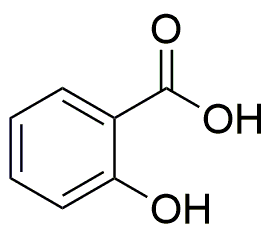Salicylic acid is widely utilized in research focused on:
- Pharmaceuticals: It is a key ingredient in many topical treatments for acne and psoriasis, helping to reduce inflammation and promote skin exfoliation.
- Agriculture: As a plant hormone, it plays a crucial role in enhancing plant growth and resistance to pathogens, making it valuable in crop protection products.
- Cosmetics: Commonly found in skincare products, it aids in treating oily skin and preventing breakouts, appealing to consumers seeking effective beauty solutions.
- Food Preservation: Its antimicrobial properties make it useful in extending the shelf life of certain food products, providing a natural alternative to synthetic preservatives.
- Analytical Chemistry: Salicylic acid is employed in various analytical methods, including spectrophotometry, to determine the concentration of compounds in a solution, benefiting researchers in quality control.
General Information
Properties
Safety and Regulations
Applications
Salicylic acid is widely utilized in research focused on:
- Pharmaceuticals: It is a key ingredient in many topical treatments for acne and psoriasis, helping to reduce inflammation and promote skin exfoliation.
- Agriculture: As a plant hormone, it plays a crucial role in enhancing plant growth and resistance to pathogens, making it valuable in crop protection products.
- Cosmetics: Commonly found in skincare products, it aids in treating oily skin and preventing breakouts, appealing to consumers seeking effective beauty solutions.
- Food Preservation: Its antimicrobial properties make it useful in extending the shelf life of certain food products, providing a natural alternative to synthetic preservatives.
- Analytical Chemistry: Salicylic acid is employed in various analytical methods, including spectrophotometry, to determine the concentration of compounds in a solution, benefiting researchers in quality control.
Documents
Safety Data Sheets (SDS)
The SDS provides comprehensive safety information on handling, storage, and disposal of the product.
Product Specification (PS)
The PS provides a comprehensive breakdown of the product’s properties, including chemical composition, physical state, purity, and storage requirements. It also details acceptable quality ranges and the product's intended applications.
Certificates of Analysis (COA)
Search for Certificates of Analysis (COA) by entering the products Lot Number. Lot and Batch Numbers can be found on a product’s label following the words ‘Lot’ or ‘Batch’.
*Catalog Number
*Lot Number
Certificates Of Origin (COO)
This COO confirms the country where the product was manufactured, and also details the materials and components used in it and whether it is derived from natural, synthetic, or other specific sources. This certificate may be required for customs, trade, and regulatory compliance.
*Catalog Number
*Lot Number
Safety Data Sheets (SDS)
The SDS provides comprehensive safety information on handling, storage, and disposal of the product.
DownloadProduct Specification (PS)
The PS provides a comprehensive breakdown of the product’s properties, including chemical composition, physical state, purity, and storage requirements. It also details acceptable quality ranges and the product's intended applications.
DownloadCertificates of Analysis (COA)
Search for Certificates of Analysis (COA) by entering the products Lot Number. Lot and Batch Numbers can be found on a product’s label following the words ‘Lot’ or ‘Batch’.
*Catalog Number
*Lot Number
Certificates Of Origin (COO)
This COO confirms the country where the product was manufactured, and also details the materials and components used in it and whether it is derived from natural, synthetic, or other specific sources. This certificate may be required for customs, trade, and regulatory compliance.


